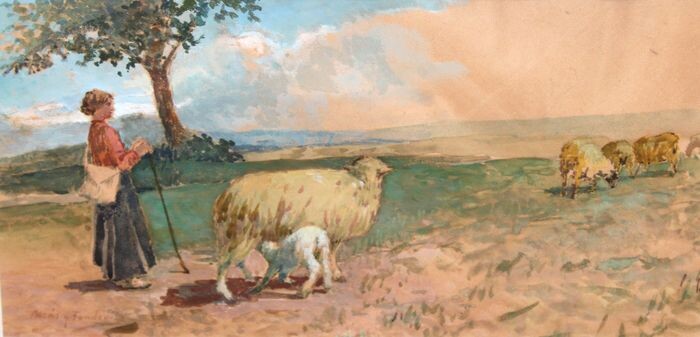Arcadi Mas i Fondevila (1852-1934) - Pastora con rebaño
\Artist: Arcadi Mas i Fondevila (1852-1934)
Technique: Mixed media\Signature: Hand signed\Dimensions: 33_45_3_cm
The painting is signed at the bottom The painting is framed The painting is in good condition Dimensions of the painting: 13 cm height x 25 cm width. Dimensions of the painting (framed) : 33 cm height x 45 cm width. (Barcelona, 1852-1934) . Spanish painter. He began his studies at the Lonja school of Barcelona, with Antonio Caba. In 1872 he travelled to Madrid to see the Exposición Nacional and visit the Prado Museum. There, he was impressed with Velázquez's painting. In 1874 the king bought his work Pel juny la falç al puny and that same year he obtained a scholarship to go to Rome, the Fortuny Pension, created by the City Council of Barcelona on the death of the artist. During his stay he devoted himself to do research about the Italian colourists, making copies of Giandomenico Tiepolo, and practicing Orientalist subject-matters in the style of Mariano Fortuny. Niño pompeyano or Estudio de desnudo are from that period. In 1882 he returned to Barcelona and participated in an exhibition at Sala Parés. That same year he moved to Sitges, invited by the painter Juan Roig y Soler, who gave him the opportunity to practice outdoor painting and detach himself from academicism. This was the moment when he painted Las lagunas de Venecia. In 1883 he returned to Rome, where he stayed for three years, alternating his stay with visits to Sitges, a town with which he remained linked on his return, after he settled in Barcelona. In 1895 he travelled to Granada with Santiago Rusiñol, with whom he created the Escola de Sitges, which became the most important centre of Catalan modernism. From this period are La pesca, El órgano de la parroquia de Sitges (Museo Maricel, Sitges, Barcelona) , Viernes Santo (Biblioteca-Museu Víctor Balaguer of Villanueva y Geltrú, Barcelona) and the numerous gardens he painted under Rusiñol’s influence. In 1928 he collaborated in one of the ceilings of San Jorge’s Hall, in the palace of the Generalitat of Barcelona, which covered Joaquín Torres-García’s noucentist murals. The Prado Museum has one of his oil paintings, with which he obtained a second class medal at the 1887 Exposición Nacional.
View it on
Estimate
Time, Location
Auction House
\Artist: Arcadi Mas i Fondevila (1852-1934)
Technique: Mixed media\Signature: Hand signed\Dimensions: 33_45_3_cm
The painting is signed at the bottom The painting is framed The painting is in good condition Dimensions of the painting: 13 cm height x 25 cm width. Dimensions of the painting (framed) : 33 cm height x 45 cm width. (Barcelona, 1852-1934) . Spanish painter. He began his studies at the Lonja school of Barcelona, with Antonio Caba. In 1872 he travelled to Madrid to see the Exposición Nacional and visit the Prado Museum. There, he was impressed with Velázquez's painting. In 1874 the king bought his work Pel juny la falç al puny and that same year he obtained a scholarship to go to Rome, the Fortuny Pension, created by the City Council of Barcelona on the death of the artist. During his stay he devoted himself to do research about the Italian colourists, making copies of Giandomenico Tiepolo, and practicing Orientalist subject-matters in the style of Mariano Fortuny. Niño pompeyano or Estudio de desnudo are from that period. In 1882 he returned to Barcelona and participated in an exhibition at Sala Parés. That same year he moved to Sitges, invited by the painter Juan Roig y Soler, who gave him the opportunity to practice outdoor painting and detach himself from academicism. This was the moment when he painted Las lagunas de Venecia. In 1883 he returned to Rome, where he stayed for three years, alternating his stay with visits to Sitges, a town with which he remained linked on his return, after he settled in Barcelona. In 1895 he travelled to Granada with Santiago Rusiñol, with whom he created the Escola de Sitges, which became the most important centre of Catalan modernism. From this period are La pesca, El órgano de la parroquia de Sitges (Museo Maricel, Sitges, Barcelona) , Viernes Santo (Biblioteca-Museu Víctor Balaguer of Villanueva y Geltrú, Barcelona) and the numerous gardens he painted under Rusiñol’s influence. In 1928 he collaborated in one of the ceilings of San Jorge’s Hall, in the palace of the Generalitat of Barcelona, which covered Joaquín Torres-García’s noucentist murals. The Prado Museum has one of his oil paintings, with which he obtained a second class medal at the 1887 Exposición Nacional.



